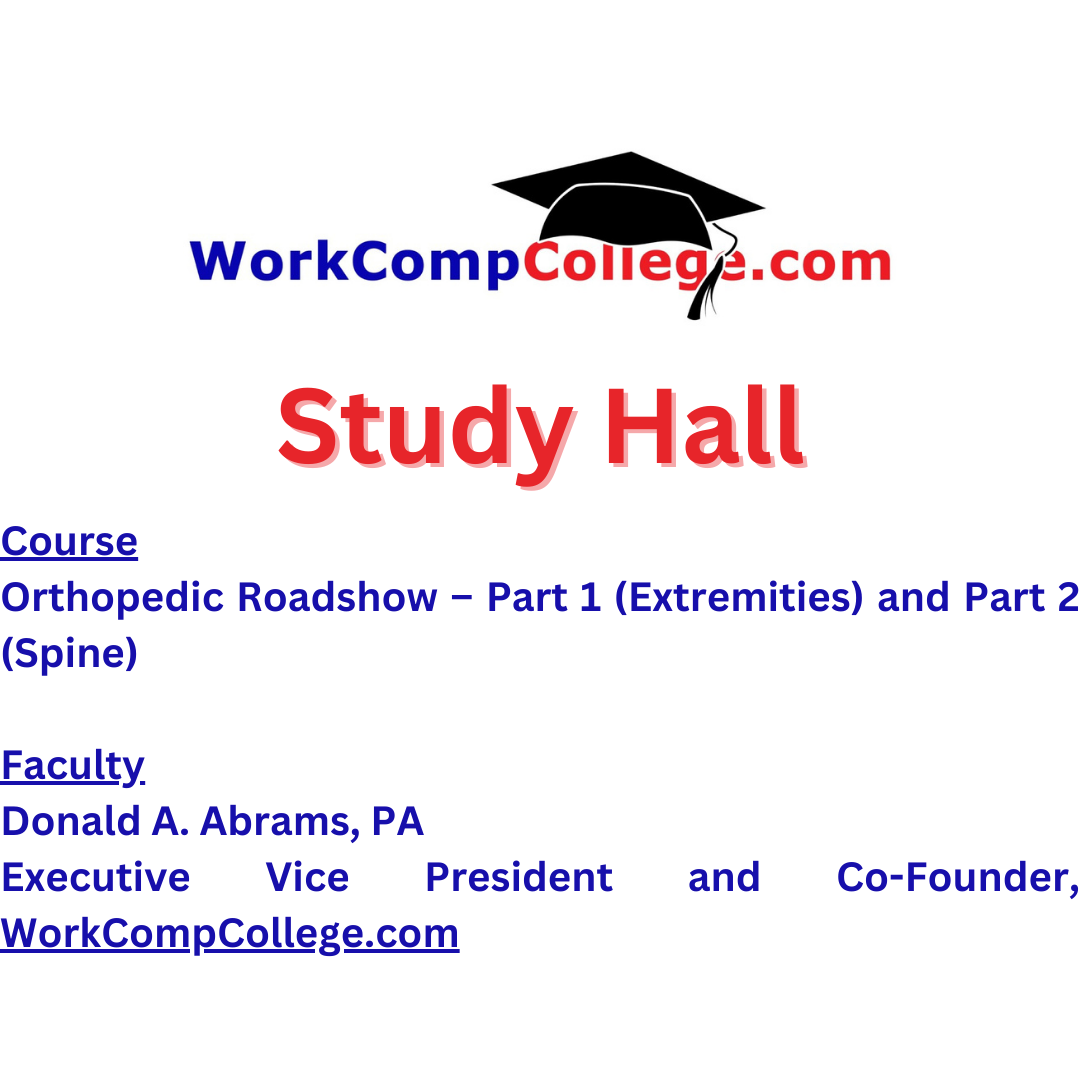Share This Article:

| Curriculum | Workers’ Recovery Professional (WRP) |
| Course | Orthopedic Roadshow – Part 1 (Extremities) and Part 2 (Spine) |
| School | Medical Management |
| Faculty | Donald A. Abrams, PA Executive Vice President and Co-Founder, WorkCompCollege.com |
Donald A. Abrams, PA is a 1977 graduate of the Albany Medical College Physician Assistant program, specializing in and actively practicing orthopedic surgery for more than 15 years. Overseeing several exceptionally successful start-ups, Mr. Abrams has established himself as a leader in cost containment strategies for the workers’ compensation professional. Now celebrating his tenth year with Clinical Compensation Consultants, Mr. Abrams has participated and spoken at hundreds of local, regional, and national educational conferences on a multipole of topics germane to the work comp professional. Additionally, Mr. Abrams has presented several webinar-based lectures endorsed for continuing education credits by the Texas Department of Insurance. Described as an excellent and passionate speaker, Mr. Abrams continues to strive to deliver a level of expertise that best serves all participants in the workers’ compensation system.
Why did you choose this subject matter to teach?
As a long-tenured Physician’s Assistant (PA) who provided clinical services in orthopedics, it is clear to me that one cannot successfully describe the noted pathology without a thorough understanding of basic human anatomy. One must be able to describe the exact structure involved, the location within that structure, and the type of pathology identified. This is true whether it is a clinician documenting the pathology or someone reading that clinician’s notes and acting upon them. Since each workers’ compensation injury is, by definition, a traumatic event involving specific components of the human anatomy, the individual adjudicating the issues surrounding compensability and medical treatment must understand the basic concepts of anatomy and attendant language. To enable the participants in the work comp ecosystem to fully understand the lexicon and intent of any clinical documents, a comprehensive assessment of the anatomy must be delivered. My goal for each student is to better understand medical anatomical terms so they can be equipped to better understand a clinician’s reports.
Why is this subject matter important to Work Comp stakeholders?
Each participant involved in the adjudication of workers compensation injuries must review clinical records, progress notes, imaging studies, and other documents that speak in the language of human anatomy. A majority of work comp claims involve musculoskeletal injuries, making anatomy a key component of understanding not just the injury but also what will be required for recovery. To fully understand the intent of those records, one must also know basic human anatomy. As such, identifying the difference between distal vs. caudal, thoracic vs. cervical, and acute vs. degenerative / chronic is paramount to successfully providing all clinically and compensable appropriate services to that injured individual. One simply cannot pursue a specific path without a noted road map enabling achievement of the intended goal. Claims professionals responsible for interpreting and acting upon clinical information often have no formal medical training and thus are at a disadvantage when presented with terminology for which they have no context.
How does your content help further a workers’ recovery mindset?
The claims professional’s enhanced ability to identify the compromised pathology and exact nature of the injury helps create a clearer path to physical recovery. Improved understanding of what is or is not a function of the reported mechanism of injury based on the interpretation of diagnostic imaging studies enables the non-medical work comp stakeholder to assess and endorse appropriate treatment more accurately. As importantly, it can accelerate the adjudication of the claim file thereby increasing the pace of care and advancement towards closure. The focus of WorkCompCollege is on establishing an industry-wide workers’ recovery mindset, so any information that can provide more confidence in the diagnosis, treatment and prognosis will facilitate better communication with the injured worker as their wellbeing becomes central to the process.
What are five takeaways or action items for students?
(1) Understand foundational physical anatomy.
(2) Identify basic directions as described in progress notes or diagnostic imaging studies.
(3) Define common injuries (fractures vs. sprain vs. strain, etc.).
(4) Compare acute vs. chronic and how to ascertain.
(5) Beginning the discussion on what is associated with the identified mechanism of injury versus what is not.
Read Also
- Apr 27, 2025
- Nikki Mehrpoo
- Apr 25, 2025
- WorkersCompensation.com
About The Author
About The Author
- WorkCompCollege
More by This Author
Read More
- Apr 27, 2025
- Nikki Mehrpoo
- Apr 25, 2025
- WorkersCompensation.com
- Apr 01, 2025
- Nikki Mehrpoo
- Mar 10, 2025
- WorkCompCollege
- Feb 10, 2025
- WorkersCompensation.com
- Jan 19, 2025
- Claire Muselman




